Introduction: Spanish Cuisine
Spanish cuisine has a rich history, influenced by its diverse geography and cultural heritage. From the mountainous regions in the north to the Mediterranean coastline in the south, Spain’s cuisine features a wide variety of dishes, ingredients, and flavors. Spanish cuisine is known for its heavy reliance on fresh ingredients, including seafood, meats, vegetables, and fruits. In this article, we will explore some of the traditional dishes in Spanish cuisine.
Appetizers: Tapas and Pinchos
Tapas and pinchos are popular appetizers in Spanish cuisine. Tapas are small dishes that are served with drinks in bars and restaurants. They can be hot or cold and can include a variety of ingredients such as olives, cheese, ham, and seafood. Pinchos, similar to tapas, are small bites served on top of a slice of bread or a skewer. They can be found in bars and restaurants in the northern regions of Spain, particularly in the Basque country. Some popular tapas and pinchos dishes include patatas bravas, croquetas, and tortilla española.
Main courses: Paella and Cocido
Paella is a rice dish that originated in Valencia, a region on the eastern coast of Spain. It is a classic Spanish dish that has become popular around the world. Paella typically consists of rice, saffron, vegetables, and meat or seafood. The dish is cooked over an open flame, giving it a smoky flavor. Cocido is a hearty stew made with meat, vegetables, and chickpeas. It is a popular dish in the central regions of Spain, particularly in Madrid. It is a comforting dish that is often served on Sundays and enjoyed with family and friends.
Desserts: Churros and Tarta de Santiago
Churros are a popular Spanish dessert that is enjoyed with hot chocolate or coffee. They are long, thin doughnuts that are deep-fried and dusted with sugar. They are often served with a side of warm chocolate sauce for dipping. Tarta de Santiago is a traditional almond cake that originated in Galicia, a region in the northwest of Spain. The cake is made with ground almonds, sugar, and eggs. It is typically dusted with powdered sugar and has a distinctive cross on the top made with powdered sugar or almonds.
Beverages: Sangria and Horchata
Sangria is a popular drink that originated in Spain. It is made with red wine, fruit, and brandy or rum. It is a refreshing drink that is often enjoyed during the summer months. Horchata is a cold, sweet drink that is made with ground almonds, rice, and sugar. It is a popular drink in the southern regions of Spain, particularly in Valencia.
Conclusion: Importance of Spanish cuisine
Spanish cuisine is known for its diverse flavors and fresh ingredients. It is a cuisine that has been influenced by many cultures, including the Romans, Moors, and Jews. Spanish cuisine has gained popularity around the world and has become a staple in many restaurants. It is a cuisine that celebrates family, friends, and community. Whether it’s enjoying a plate of tapas or a hearty bowl of paella, Spanish cuisine is a celebration of life and all its flavors.

